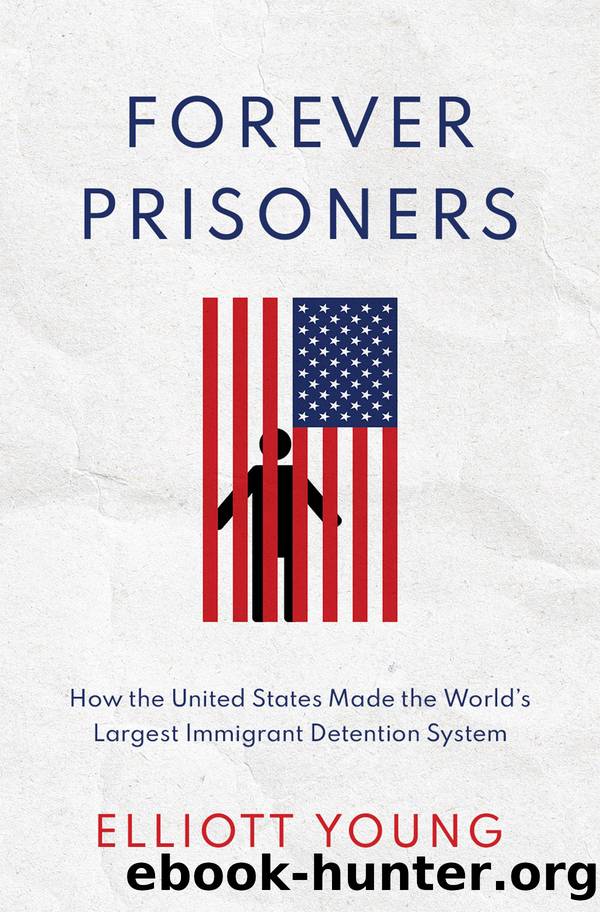Forever Prisoners: How the United States Made the World's Largest Immigrant Detention System by Elliott Young

Author:Elliott Young [Young, Elliott]
Language: eng
Format: epub
Tags: history, United States, 19th Century, 20th Century, law, Emigration & Immigration
ISBN: 9780190085957
Google: yIkIEAAAQBAJ
Publisher: Oxford University Press
Published: 2021-11-15T00:31:14.537551+00:00
Resisting Detention
The proximate cause of the 1987 prison uprising was the imminent deportation of Cubans, but detainees had long-standing complaints about conditions in the prisons, their lack of due process, and their indefinite detention. At a 1988 congressional hearing, Deputy Attorney General Burns asserted that the 1987 prison uprising was a response to the November agreement between the United States and Cuba to deport excludable detainees. However, that narrative ignores the long history of riots and violence at detainee camps and prisons. In fact, from the moment Cubans were locked up in 1980, they regularly attempted to escape, destroyed prison facilities, and engaged in hunger strikes and suicide attempts as desperate acts of resistance. At Fort Chaffee, 200 detainees tried to escape through an unlocked gate at the end of May 1980, and a week later 1,000 detainees burned buildings and stormed the gates. By the end of the confrontation with Arkansas State Troopers, one Cuban was killed, forty were seriously injured, and fifteen state troopers were hurt. Around the same time as the Fort Chaffee escape attempt, sixty detainees at the prison at Fort Walton Beach, Florida, threw rocks at guards while dozens tried to scale a barbed wire fence. These prison rebellions had three effects. First, security at detainee camps was militarized, with thousands of army soldiers acting as guards. Second, the rebellions helped to popularize the myth of Marielitos as hardened and violent criminals. And third, the outbreaks forced the government to speed up the processing of detainees. By October 1980, almost all of the 120,000 Marielitos had been released into the community. The INS, however, identified 1,306 âpotentially excludableâ Cubans whom they scattered across the country in several minimum-security prisons and eventually paroled. A much smaller group of 350, representing less than half of 1 percent of the total number of Marielitos, were deemed by the INS to have serious criminal backgrounds. This group was sent to a US penitentiary in Talladega, Alabama, for indefinite detention.56
The view from inside the prison looked very different depending on who was reporting. Spanish-language newsletters produced at Fort Chaffee by the Cubans and overseen by camp officials provided a heavily censored view of life inside the camp. La Vida Nueva, for example, published an editorial from a Cuban detainee that condemned the rioters, declaring âââonly a perfect imbecile or a Castro agent could be so impatientâ as to participate in the riots.â57 While this official view of the Fort Chaffee uprising was perhaps shared by some of the detainees, others recognized the irony of being placed in a military prison camp surrounded by barbed wire in the land of liberty. As one journalist who described the similarities between the Cuban port of Mariel and Fort Chaffee put it, âThere are barricades, loudspeakers, with voices in Cuban accents urging âadelanteâââget movingââand men in uniforms, carrying clubs, posted every few yards.â58 One young detainee, Rosendo Tabio, remarked simply, âIâm in America, but Iâm not free.â59 In countless letters sent from the Atlanta
Download
This site does not store any files on its server. We only index and link to content provided by other sites. Please contact the content providers to delete copyright contents if any and email us, we'll remove relevant links or contents immediately.
| Africa | Americas |
| Arctic & Antarctica | Asia |
| Australia & Oceania | Europe |
| Middle East | Russia |
| United States | World |
| Ancient Civilizations | Military |
| Historical Study & Educational Resources |
Machine Learning at Scale with H2O by Gregory Keys | David Whiting(4185)
Never by Ken Follett(3794)
Fairy Tale by Stephen King(3220)
The Man Who Died Twice by Richard Osman(2997)
Oathbringer (The Stormlight Archive, Book 3) by Brandon Sanderson(2888)
Will by Will Smith(2794)
Rationality by Steven Pinker(2291)
The Dark Hours by Michael Connelly(2245)
Can't Hurt Me: Master Your Mind and Defy the Odds - Clean Edition by David Goggins(2228)
The Dawn of Everything: A New History of Humanity by David Graeber & David Wengrow(2122)
Friends, Lovers, and the Big Terrible Thing by Matthew Perry(2119)
Principles for Dealing With the Changing World Order: Why Nations Succeed and Fail by Ray Dalio(1974)
HBR's 10 Must Reads 2022 by Harvard Business Review(1777)
A Short History of War by Jeremy Black(1762)
Go Tell the Bees That I Am Gone by Diana Gabaldon(1687)
515945210 by Unknown(1599)
A Game of Thrones (The Illustrated Edition) by George R. R. Martin(1589)
Kingdom of Ash by Maas Sarah J(1527)
443319537 by Unknown(1470)
